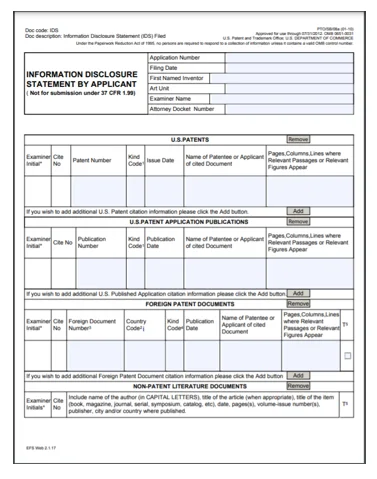Why Outsourcing Information Disclosure Statement (IDS) Management Is a Cost-Effective Solution?
With the rise in patent filings, the workload for IP attorneys, law firms, and solo practitioners has increased significantly. One key responsibility in this process is the Information Disclosure Statement (IDS), a critical part of patent prosecution. Managing an IDS requires careful attention to office actions and prior art submissions, making it a time-consuming and meticulous task. Outsourcing this task to experienced IP service providers is an effective way to reduce costs and administrative burdens.
In this article, we will discuss how outsourcing Information Disclosure Statement management can reduce costs and alleviate administrative burdens.
Table of Contents
The Importance of the Information Disclosure Statement
IDS plays a vital role in the patenting process. Applicants are required to disclose any prior art relevant to their invention’s patentability. Failure to file a proper IDS could result in severe consequences, including the unenforceability of the patent due to inequitable conduct. Filing an accurate IDS strengthens a patent’s enforceability and protects it from challenges, making it a crucial step in patent prosecution.
Key Components of an IDS
An IDS includes three types of prior art:
- U.S. Patents and Publications: Prior art from U.S. patents and published U.S. applications.
- Foreign Patents and Publications: Patents and applications from foreign jurisdictions, including PCT applications.
- Non-Patent Literature (NPL): This covers other relevant publications, including scientific articles, books, and reports.
Each IDS must include accurate, legible copies of foreign patents and NPL documents, along with translations if necessary.
The Process of IDS Preparation
Preparing an IDS involves several steps:
- Checking Filing Requirements: Determine whether to file an initial, supplemental, or Quick Path Information Disclosure Statement (QPIDS).
- Cross-Referencing and Avoiding Duplicity: Ensure no duplicate citations from previously filed submissions.
- Reference Entry: Enter all relevant references, including bibliographic data and any required translations.
- Filing: Submit the IDS along with fees, documents, and certification if required.

Why Outsource IDS Management?
Outsourcing Information Disclosure Statement management offers several key advantages:
- Efficient Reference Entry: IP service providers help gather references from co-pending applications, ensuring proper citation in the IDS.
- Timely Filing: By managing timelines, outsourcing partners ensure that no deadlines are missed, avoiding penalties.
- Cost Savings: Outsourcing reduces the risk of incurring fees due to missed or late submissions.
- Centralized Management: Service providers can store prior art documents for future use, saving time and effort during subsequent filings.
Sagacious IP’s Approach to IDS Management
At Sagacious IP, we offer comprehensive management of Information Disclosure Statement filings, ensuring timely submission and proper citation of prior art. Our team monitors client portfolios to track office actions and updates, preventing missed deadlines and costly delays. By proactively managing each IDS, we help clients avoid unnecessary USPTO fees and RCE costs while streamlining the overall patent prosecution process.
For instance, if an International Search Report (ISR) is overlooked in a PCT application, it can complicate the prosecution process. Sagacious IP ensures that all references are filed on time, preventing delays and ensuring a smoother journey to patent issuance.
Conclusion
Managing the Information Disclosure Statement is a crucial yet labor-intensive task that can be significantly streamlined through outsourcing. By partnering with experienced IP service providers, businesses can reduce costs, save time, and ensure compliance with all filing requirements. Sagacious IP’s expertise in IDS management helps clients stay on top of their patent prosecution needs, allowing them to focus on higher-level legal tasks.
If you’re looking for expert assistance with your IDS preparation, Sagacious IP is here to help. Don’t let the complexities of IDS management hold back your innovation. Contact us today to streamline your process and enhance your patent strategy!
– Rashi Sethi, Chandani Sharma (IPMS), and the Editorial Team
Having Queries? Contact Us Now!
"*" indicates required fields




